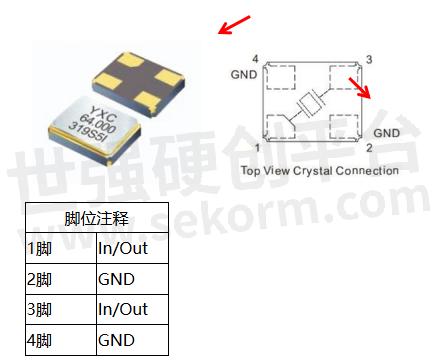Does a Passive Crystal Oscillator Have a Direction?




A passive crystal oscillator has no direction, and the pins of a passive crystal oscillator do not distinguish between positive and negative poles.
How do you identify the direction of a passive crystal oscillator? Will there be any problem if the passive crystal oscillator is pasted upside down?
First of all, it is necessary to clarify that crystal oscillators are divided into two categories: passive crystal oscillators and active crystal oscillators. The English name of a passive crystal oscillator is Crystal, and its full name in Chinese is quartz crystal resonator. Some people also like to call passive crystal oscillators crystals. The English name of an active crystal oscillator is Oscillator, and its full name in Chinese is quartz crystal oscillator, also known as clock oscillator, and some people directly call it OSC.
Two-pin passive crystal oscillator: one pin is the frequency output pin, and the other pin is the frequency input pin. Even if it is reversed, the crystal oscillator still works normally.
Four-pin patch passive crystal oscillator: Generally, pins 1 and 3 are the frequency input pins and frequency output pins, and the other two pins (pins 2 and 4) are ground pins. Even if it is rotated 180 degrees, only pin 1 and pin 3 are swapped, that is, the input pin becomes the output pin, and the output pin becomes the input pin. The crystal oscillator can still work normally, and there will be no performance and function differences.

Active crystal oscillators have directionality, and they will be damaged by current if they are attached upside down. Passive crystal oscillators have no directionality, and it doesn't matter if they are attached upside down. In other words: whether the passive crystal oscillator is plug-in type or SMD type, or has two or four pins, there is no distinction between positive and negative poles, and no directionality when attaching or welding, so don't worry about attaching it upside down.
- |
- +1 赞 0
- 收藏
- 评论 0
本文由雪飘梦飞转载自YXC Official Website,原文标题为:Does a passive crystal oscillator have a direction?,本站所有转载文章系出于传递更多信息之目的,且明确注明来源,不希望被转载的媒体或个人可与我们联系,我们将立即进行删除处理。
相关推荐
What are the Common Cutting Processes for Crystal Oscillators
The more common cutting types of crystal oscillators are briefly introduced in three types: AT, BT, and SC cutting.
Introduction of the Crystal Resonator Structure
This article is an introduction to the crystal resonator structure. The crystal in the crystal resonator refers to quartz crystal, and its chemical formula is silicon dioxide SiO2.
There are Two Main Types of Crystal Oscillators: Active Crystal Oscillators and Passive Crystal Oscillators
Self-oscillation characteristics of active crystal oscillators and usage requirements of passive crystal oscillators. The content involves the internal structure of crystal oscillators, especially the piezoelectric effect of quartz crystals and their role in mechanical vibration.
YXC automotive grade resonator 8MHz, Passive Crystal Oscillator 3225 Package for Car Bluetooth Module
Bluetooth module is a PCBA board with integrated Bluetooth function, which is used for short-distance wireless communication. It is divided into Bluetooth data module and Bluetooth voice module according to its function. Bluetooth module refers to a collection of basic circuits of chips with integrated Bluetooth function, which is used for wireless network communication.
YXC 24MHz Car-standard resonator, Load 8PF, Operating Temperature -40~125℃, Used in Body Domain Control-TMCU Geely
The body domain controller is one of the key components of modern automotive electronic systems. It is an intelligent control unit that can centrally control various electronic modules and systems of the body. Its main function is to process and manage information from body electronic modules and coordinate communication and data transmission between various modules to achieve unified management and control of the body system.
YXC 16MHz Automotive-grade Resonator YSX321SC, 3225-4P Package, Operating Temperature -40~125℃, Used in Vehicle HUD
the HUD system displays relevant driving information, such as vehicle speed, navigation instructions, warnings, etc., directly on a transparent display panel in front of the driver‘s field of vision by mapping images or information. The clock signal of the crystal oscillator is used to control image generation and update, ensuring that the image is updated within a sustained time interval and maintaining the real-time and continuity of information.
How Does Crystal Meet the Age of 5G Communication
Crystal is the core electronic component of 5G technology. Its role is to provide high-end reference clock signals and receive transmission signals. 5G technology must be very accurate and efficient in all aspects, so the requirements for the crystal oscillator will be as high as possible.
Tips for Crystal Oscillator Circuit Design, Essential Skills for Engineers!
As an indispensable signal transmitter in the clock circuit, the crystal oscillator is required for the microcontroller to operate normally. Therefore, the participation of the crystal oscillator is also indispensable in the design of electronic circuits. A good crystal oscillator circuit design can provide the best space utilization for electronics and play the greatest functional role.
Temperature Compensated Crystal Oscillator Is Also One of The Quartz Crystal Oscillators, Referred to as “temperature Compensated Crystal Oscillator“
What are the characteristics of temperature compensated crystal oscillator? Because electronic products in different fields have different demands for quartz crystal oscillators, and temperature-compensated crystal oscillators were developed to compensate for the instability of ordinary crystal oscillators at high temperatures. However, temperature-compensated crystal oscillators have There are many types of temperature compensated crystal oscillators, each with its own characteristics.
Crystal Oscillator PPM Error Analysis and Calculation Method
Crystal oscillator accuracy is usually measured in PPM, which describes the frequency stability or deviation of the crystal oscillator. PPM represents the relative error between the actual output frequency and the nominal frequency, and is an important parameter for measuring the frequency accuracy of the crystal oscillator.
电子商城
现货市场





































































































































































































登录 | 立即注册
提交评论